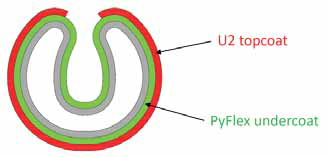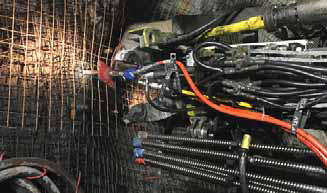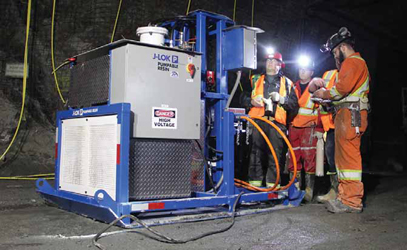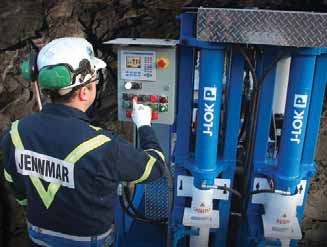
Jennmar’s J-Lok P system, seen here in an underground gold mine in Canada, can
be used to inject resin into Multiple Point Anchor (MPA) bolts in deep mines with
squeezing ground conditions.
Jennmar Develops Rock Bolting
Solutions
Solving the pumpable resin riddle, a new automated resin system should improve
safety for hard-rock miners working in difficult geology
By Steve Fiscor, Editor-in-Chief

If the miners are going to win the battle in these extreme conditions, they will have to add some new tools to their arsenal. One of the leading ground control suppliers, Jennmar, has recently announced three big developments: the self-drilling, yieldable Multiple Point Anchor (MPA) bolt, an improved inflatable bolt with a corrosion-resistant coating, and a pumpable resin injection system, J-Lok P.
The resin injection system not only keeps the operators out of harm’s way, it opens the gateway for automated bolting processes, which will improve productivity. The gold-hosting geology in Nevada also contains a salt that creates a corrosive environment that is hostile toward iron. Traditional rock-bolting methods were not working. Jennmar assigned its engineers to the problem and they developed a new corrosion-resistant coating that will allow the miners to continue to use inflatable systems.
Developing the Pumpable Resin System
“Over the years, many engineers have attempted to develop
a pumpable resin system, but none of them succeeded until
now,” said Dr. John Stankus, president, Keystone Mining Service, the engineering affiliate of Jennmar. “We came up
with some new ideas and now have several machines in operation.
To get to that automated system, where an operator
does not have to leave his station to insert a cartridge, especially
in the high places out West, that has been a big push
for Jennmar. These self-drilling pumpable hollow-bar bolts,
which are designated MPA, have multiple point-anchor locations
that yield under load, will work great for deep mines
with high stress and squeezing ground.”
This injectable resin aspect of the system is really slick, Stankus explained. “The units can mount right on the bolting machines or be a stand-alone, skid-mounted unit,” Stankus said. “It’s all computer-controlled with a monitor in the cabin and the operator does not have to leave his station.”
Different ground control professionals have tried to develop this system since miners started using resin and Jennmar finally solved the riddle. They developed a special manifold that allows the pump to push resin through a two-line system into the hole using an injection nozzle. Resin is relatively abrasive. Jennmar’s J-Lok subsidiary developed a new resin that pumps easier and is less abrasive. Then they developed a set of special cylinders as part of the pumping system that would withstand the abrasion.
Alternative Rock Bolting Technologies
The MPA is a hollow core bolt with an R32 coarse thread that
was developed specifically for the deep mines, which are experiencing
problems with the squeezing ground, explained Stankus.
“In some cases, in the time between driling the hole and installing
the bolt, the hole had closed,” Stankus said. “Because
of the heavy pressure, they needed a self-drilling, one-pass bolt
that would yield and they were asking for 6 inches of yield.”

The sacrificial bit on the MPA has holes that allow the use of pumpable resin. The operators drill the hole, the J Lok P system pumps the resin through the bolt, filling bolt and the void between it and the borehole. The operator loads a 45-lb bag of resin into the cylinders on the machine, which pumps the resin and catalyst in to hole. “Lots of people have tried to develop this over the years,” Stankus said. “They key is to pump the resin and catalyst into the hole without mixing the two.” The breakthrough was the manifold that Jennmar developed.
The machine drills the holes with a self-drilling bolt. The operator pulls off the bolt, attaches the J-Lok P system and then injects the resin safely from the cab. The bolt is fully grouted and protected from corrosion. “It’s actually a double-protection system because of the resin inside the hollow core and the resin that fills the space around the bolt in the drill hole,” Stankus said.
The corrosion the Nevada gold miners are experiencing is related to the sodium in the salt compounds found in the geologic formation. The salt compounds are prevalent in a horizon about 20 inches (in.) to 30 in. above the ore zone. In as little as a few months, bolts would corrode and fall out of the roof. They couldn’t support themselves let alone the rock.

The coating is corrosion resistant, so it is important that rock in the boreholes does not scrape the coating off the Python during the installation process. “We developed this coating that resisted the salt corrosion, PyFlex, but we needed to keep the coating on the inflatable bolt,” Stankus said. “The solution was to develop a sacrificial urethane coating that preserves the corrosion- resistant coating during bolt insertion and installation.”
If the coating is too stiff, it would break apart when the bolt inflates. Yet, it also had to have flexural strength. “We had to find a coating that was substantial enough to resist the salt corrosion, but had the flexural strength to stretch and not crack during the inflation process,” he said.
Stankus believe these two new rock bolts, the MPA with J-Lok P resin injection and the corrosion-resistant Python M3 with PyFlexU2 coating, will be game changers for deep hardrock mining operations.

Traditionally, miners would shove a resin cartridge in the hole, which exposes them to risks. Now the bolting machine operator would have a carousel on the rig that is loaded with six or eight bolts with sacrificial bits. Sitting safely inside the cab using PLC controls, the operator drills the hole, pushes a button to switch off the bolt and attach the resin nozzle, and then he pushes another button that injects a preprogrammed amount of resin for the length of the bolt and the hole diameter.
“We took the unit to Canada first and tested it,” Stankus said. “We brought it back to the plant in Pennsylvania and modified it. Now we are testing it in western U.S., with demonstrations requested at several hard rock mines in Canada.”
Jennmar’s engineers developed this system in house. Stankus compared the first prototype that was trialed in Canada to the Model T. With the help of Royal Hydraulic, they streamlined the system, which was then tested in Nevada. Jennmar knows their strengths, which is using steel underground for roof support, not hydraulics. So, they partnered with Royal Hydraulic, which a well-known and respected Pennsylvania supplier familiar with the mining business, albeit mostly on the coal-side of the business. Jennmar has now signed a long-term agreement with Royal Hydraulic to supply pumps to support the mines in North America.

*Editor’s Note:
Patents applied for J-Lok P, MPA, PythonM3 and
PyFlexU2.